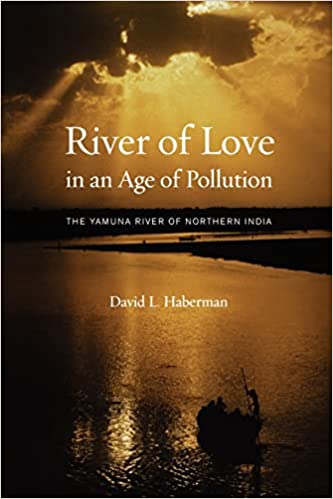
David Haberman’s River of Love in an Age of Pollution: The Yamuna River of Northern India (published by the University of California Press in 2006) examines Yamuna – a sacred river venerated by Hindus. Yamuna is conceptualized as a goddess flowing with love, yet in its current form, it is severely polluted. As the story depicts the flow of joy, the problems, love, religion, and the birth and death of the river, we are introduced to the story of the fighting spirit of the river Yamuna, once highly sacred and extremely significant to humanity.
The book is divided into six chapters, namely : (1) A River of Delights, (2) The Source: Mother of life. (3) River of Death. (4) Goddess of Love. (5) Signs of Hope. (6) A Matter of Balance. There are both joys and problems associated with the river in the first chapter of the book. The author recalls a day when he was admiring a river’s beauty from a distance. But when he got close to the river, he was astounded and found it difficult to comprehend what he had seen. It was polluted and had a foul odour. He then begins to investigate the relationship between ecology and religion, citing the opinions of medievalists Lynn White and deep ecologists Arne Naees regarding the ecology of the river.
Chapter two reminds us of Yamunotri’s religious and cultural significance for Hindus as it traces the history of the Yamuna river back to Yama, the Lord of Death, and Yami, an early Vedic term for the river. The Yamunotri trip is one of the most sacred in Hinduism, and Hindus believe that everyone should do the journey at least once in their lifetime. To underscore the significance of the rivers to people who identify as Hindus, he also highlights how close the rivers are to the four holiest Hindu sites: Yamunotri, Gangotri, Kedarnath, and Badrinath (all of which are included in Char Dham).
The third chapter asks: How did the river end up on the verge of dying? This chapter largely looks at the number of studies on dying rivers that started to appear in the late 1990s, with a focus on the Yamuna. But as the chapter progresses, we learn that the state’s (and people’s) selfishness was what ultimately caused it to perish. The river’s demise has been substantially impacted by the nearby industries’ careless poisoning of it. The river’s water wasn’t being purified back then because such measures had not begun. As a substitute for cleaning, governments constructed a number of smaller barrages alongside a few larger ones over the years thereby diverting the river’s natural flow. Since the water entering the river from the Himalayan heights stopped reaching the lower plains, people started to believe that the river had already died.
By taking us through religiously significant locations like Brindavan or Braj and highlighting the aspects of the river as the source of the highest divinity, the supreme lover of God, the ultimate giver to all, the perfecter of love, the purifier of all, the daughter of the Sun, and as the sister of Death, the author attempts to highlight the complex meanings associated with a river. In light of the histories of the locations that are intimately connected to the river, he wrote about all these characteristics of the Yamuna. Hindus revere Krishna, a well-known deity, who was born on the banks of the same river. When people eventually recognized Krishna as the supreme God, they acknowledged their close ties to the river. The morning greeting “Yamuna Maiyya ki jay” conveys a lot in a few words. All of these people have found the river to be a wonderful source of love, a perfect atonement for all of their crimes, and an integral part of their lives. Furthermore, he has made an effort to convey cultural perspectives on pollution, bringing up the issue of the Yamuna River’s early levels of contamination.
The book gives us some reasons to believe that Yamuna will once again be a clean river. It begins by going back to a public interest litigation (PIL) that Gopeswar Nath Chaturvedi of Mathura filed in the High Court of Allahabad, which led to the end of December 1999 being the deadline for the release of untreated effluents into the Yamuna. A sizable crowd had assembled in Braj to commemorate the court’s ruling. The fact that there were numerous additional instances of this kind in the first ten years of the twenty-first century offers some hope.
‘There`s nothing like seeing a river through the eyes of somebody who really cares about it.’ This quote from Bill Painter which appears at the beginning of the last chapter has had much success in expressing what the river of love and death is. The author has made an effort to get us to think about establishing the ideal balance and middle ground. He has eloquently highlighted the reality that humans require water and end up contaminating it in a variety of ways that can sometimes be impossible to prevent.
It is a beautifully written book that looks at the stories, theologies and religious practices of the river goddess collected from texts written over centuries and more, as well as from discussions with pilgrims, priests and worshippers. Haberman offers a detailed analysis of the environmental state of the river and explores how religious practices are affected by its current pollution. He further introduces Indian river environmentalism which is in many ways distinct from its western counterpart.
***
Ankit is a second year PhD Student in Sociology at the Faculty of Social Sciences, University of Wroclaw, Poland.